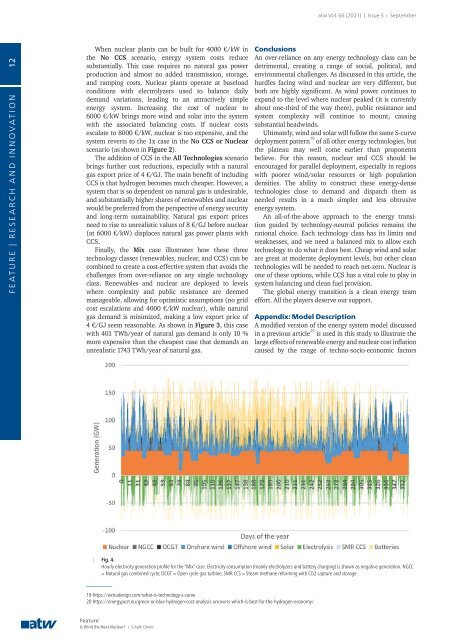atw - International Journal for Nuclear Power | 05.2021
Description Ever since its first issue in 1956, the atw – International Journal for Nuclear Power has been a publisher of specialist articles, background reports, interviews and news about developments and trends from all important sectors of nuclear energy, nuclear technology and the energy industry. Internationally current and competent, the professional journal atw is a valuable source of information. www.nucmag.com
Description
Ever since its first issue in 1956, the atw – International Journal for Nuclear Power has been a publisher of specialist articles, background reports, interviews and news about developments and trends from all important sectors of nuclear energy, nuclear technology and the energy industry. Internationally current and competent, the professional journal atw is a valuable source of information.
www.nucmag.com
You also want an ePaper? Increase the reach of your titles
YUMPU automatically turns print PDFs into web optimized ePapers that Google loves.
<strong>atw</strong> Vol. 66 (2021) | Issue 5 ı September<br />
FEATURE | RESEARCH AND INNOVATION 12<br />
When nuclear plants can be built <strong>for</strong> 4000 €/kW in<br />
the No CCS scenario, energy system costs reduce<br />
substantially. This case requires no natural gas power<br />
production and almost no added transmission, storage,<br />
and ramping costs. <strong>Nuclear</strong> plants operate at baseload<br />
conditions with electrolyzers used to balance daily<br />
demand variations, leading to an attractively simple<br />
energy system. Increasing the cost of nuclear to<br />
6000 €/kW brings more wind and solar into the system<br />
with the associated balancing costs. If nuclear costs<br />
escalate to 8000 €/kW, nuclear is too expensive, and the<br />
system reverts to the 1x case in the No CCS or <strong>Nuclear</strong><br />
scenario (as shown in Figure 2).<br />
The addition of CCS in the All Technologies scenario<br />
brings further cost reductions, especially with a natural<br />
gas export price of 4 €/GJ. The main benefit of including<br />
CCS is that hydrogen becomes much cheaper. However, a<br />
system that is so dependent on natural gas is undesirable,<br />
and substantially higher shares of renewables and nuclear<br />
would be preferred from the perspective of energy security<br />
and long-term sustainability. Natural gas export prices<br />
need to rise to unrealistic values of 8 €/GJ be<strong>for</strong>e nuclear<br />
(at 6000 €/kW) displaces natural gas power plants with<br />
CCS.<br />
Finally, the Mix case illustrates how these three<br />
technology classes (renewables, nuclear, and CCS) can be<br />
combined to create a cost-effective system that avoids the<br />
challenges from over-reliance on any single technology<br />
class. Renewables and nuclear are deployed to levels<br />
where complexity and public resistance are deemed<br />
manageable, allowing <strong>for</strong> optimistic assumptions (no grid<br />
cost escalations and 4000 €/kW nuclear), while natural<br />
gas demand is minimized, making a low export price of<br />
4 €/GJ seem reasonable. As shown in Figure 3, this case<br />
with 401 TWh/year of natural gas demand is only 10 %<br />
more expensive than the cheapest case that demands an<br />
unrealistic 1743 TWh/year of natural gas.<br />
Conclusions<br />
An over-reliance on any energy technology class can be<br />
detrimental, creating a range of social, political, and<br />
environmental challenges. As discussed in this article, the<br />
hurdles facing wind and nuclear are very different, but<br />
both are highly significant. As wind power continues to<br />
expand to the level where nuclear peaked (it is currently<br />
about one-third of the way there), public resistance and<br />
system complexity will continue to mount, causing<br />
substantial headwinds.<br />
Ultimately, wind and solar will follow the same S-curve<br />
deployment pattern 19 of all other energy technologies, but<br />
the plateau may well come earlier than proponents<br />
believe. For this reason, nuclear and CCS should be<br />
encouraged <strong>for</strong> parallel deployment, especially in regions<br />
with poorer wind/solar resources or high population<br />
densities. The ability to construct these energy-dense<br />
technologies close to demand and dispatch them as<br />
needed results in a much simpler and less obtrusive<br />
energy system.<br />
An all-of-the-above approach to the energy transition<br />
guided by technology-neutral policies remains the<br />
rational choice. Each technology class has its limits and<br />
weaknesses, and we need a balanced mix to allow each<br />
technology to do what it does best. Cheap wind and solar<br />
are great at moderate deployment levels, but other clean<br />
technologies will be needed to reach net-zero. <strong>Nuclear</strong> is<br />
one of these options, while CCS has a vital role to play in<br />
system balancing and clean fuel provision.<br />
The global energy transition is a clean energy team<br />
ef<strong>for</strong>t. All the players deserve our support.<br />
Appendix: Model Description<br />
A modified version of the energy system model discussed<br />
in a previous article 20 is used in this study to illustrate the<br />
large effects of renewable energy and nuclear cost inflation<br />
caused by the range of techno-socio-economic factors<br />
| Fig. 4.<br />
Hourly electricity generation profile <strong>for</strong> the “Mix” case. Electricity consumption (mainly electrolyzers and battery charging) is shown as negative generation. NGCC<br />
= Natural gas combined cycle; OCGT = Open cycle gas turbine; SMR CCS = Steam methane re<strong>for</strong>ming with CO2 capture and storage.<br />
19 https://extrudesign.com/what-is-technology-s-curve<br />
20 https://energypost.eu/green-or-blue-hydrogen-cost-analysis-uncovers-which-is-best-<strong>for</strong>-the-hydrogen-economy/<br />
Feature<br />
Is Wind the Next <strong>Nuclear</strong>? ı Schalk Cloete

















